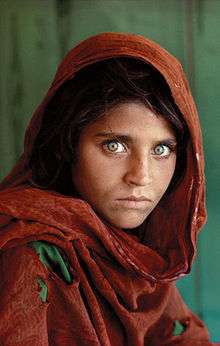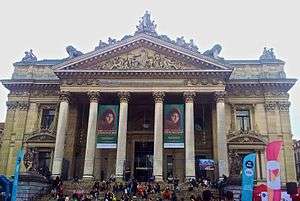Afghan Girl
Afghan Girl is a 1984 photographic portrait of Sharbat Gula (Pashto: شربت ګله) (pronounced [ˈʃaɾbat]) (born c. 1974), also known as Sharbat Bibi, taken by photojournalist Steve McCurry.[1] It appeared on the June 1985 cover of National Geographic. The image is of an adolescent girl with green eyes in a red headscarf looking intensely at the camera. The identity of the photo's subject was not initially known, but in early 2002, she was identified as Sharbat Gula. She was an Afghan child who was living in the Nasir Bagh refugee camp in Pakistan during the time of the Soviet occupation of Afghanistan when she was photographed.
Afghan Girl | |
|---|---|
شربت ګله Sharbat Gula | |
 1984 photographic portrait by journalist Steve McCurry | |
| Born | c. 1974 (age 45–46) |
| Nationality | Afghan |
| Occupation | National Geographic, BBC Pashto |
| Known for | cover photo of the June 1985 issue of National Geographic magazine |
| Spouse(s) | Rahmat Gul (?–2012; his death) |
| Children | 4 (1 deceased) |

It has been likened to Leonardo da Vinci's painting of the Mona Lisa[2][3] and has been called "the First World's Third World Mona Lisa".[4] The image became "emblematic" of "refugee girl/woman located in some distant camp" deserving of the compassion of the Western viewer.[5] It had also become a symbol of Afghanistan to the west.[6]
National Geographic
Sharbat Gula was one of the students in an informal school in the Nasir Bagh refugee camp in 1984. Sharbat Gula's photograph was taken by National Geographic Society photographer Steve McCurry on Kodachrome 64 color slide film, with a Nikon FM2 camera and Nikkor 105mm Ai-S F2.5 lens.[7] The pre-print photo retouching was done by Graphic Art Service, based in Marietta, Georgia. McCurry did not record the name of the person he had photographed.
The picture, titled Afghan Girl, appeared on the June 1985 cover of National Geographic. The image of her face, with a red scarf draped loosely over her head and her eyes staring directly into the camera was named "the most recognized photograph" in the history of the magazine, and the cover itself is one of the most famous of the National Geographic.[8] American Photo magazine says the image has an "unusual combination of grittiness and glamour".[9] Her green eyes are the subject of frequent commentary.[5][10][11]
McCurry made several unsuccessful attempts during the 1990s to locate her.[12] In January 2002, a National Geographic team traveled to Afghanistan to locate the subject. McCurry, upon learning that the Nasir Bagh refugee camp was soon to close, inquired of its remaining residents, one of whom knew Sharbat Gula's brother and was able to send word to her hometown. However, a number of women came forward and identified themselves erroneously as the famous Afghan Girl. In addition, after being shown the 1984 photo, a handful of young men erroneously identified Sharbat Gula as their wife.
The team located Sharbat Gula, then around the age of 30, in a remote region of Afghanistan; she had returned to her native country from the refugee camp in 1992. Her identity was confirmed by John Daugman using iris recognition.[13] She recalled being photographed. She had been photographed on only three occasions: in 1984 and during the search for her when a National Geographic producer took the identifying pictures that led to the reunion with Steve McCurry. She had never seen the Afghan Girl image before it was shown to her in January 2002.
Sharbat Gula
Pashtun by ethnicity and from a rural background, Sharbat Gula's family fled during the Soviet Union's bombing of Afghanistan when she was around six years old in their village in eastern Nangarhar. Along with her father, brother, and three sisters, she walked across the mountains to Pakistan and ended up in the Nasir Bagh refugee camp in Pakistan in 1984.[14]
She married Rahmat Gul between the age of 13 and 16, and returned to her village in Afghanistan in 1992. She is now a widow as her husband died from Hepatitis C virus around 2012.[15] Sharbat Gula has three daughters. A fourth daughter died in infancy. She expressed hopes that her children will be able to get an education. A devout Muslim, Sharbat Gula normally would wear a burka and was hesitant to meet with McCurry, as he was a male from outside the family. When asked if she had ever felt safe, she responded "No. But life under the Taliban was better. At least there was peace and order." Until the National Geographic team found her again, she had never seen the photo of herself as a child. When asked how she had survived, she responded that it was "the will of God".[14]
In 2015, local newspapers in Pakistan reported that the National Database and Registration Authority (NADRA) canceled the Computerized National Identity Card (CNIC) to Sharbat Bibi and two men listed as her sons. Reports claimed the national ID cards had been issued illegally. A NADRA source is quoted as saying "They may not be her sons but this is a common practice among Afghan refugees whereby they list names of non-relatives as their children to obtain documents." A relative stated that the family lives in Pakistan, but "We travel between Pakistan and Afghanistan depending on the security situation."[1]
On 26 October 2016, Sharbat Gula was arrested in Pakistan by the Federal Investigation Agency for living in the country using forged documents.[16][17] She was sentenced to fifteen days in detention, and she was deported to Afghanistan.[15][18] The decision was criticised by Amnesty International.[15] In Kabul, Sharbat Gula and her children were welcomed by President Ashraf Ghani and former President Hamid Karzai at the presidential palace. The government promised to support her financially.[19] In December 2017, Sharbat Gula was gifted a 3,000-square-foot (280 m2) residence in Kabul for her and her children to live in.[20]
Legacy
Interest in the photo increased after 9/11 attacks when the George W. Bush administration began promoting Afghan women's rights during the US military campaign in Afghanistan.[12][21]
More recent pictures of Sharbat Gula were featured as part of a cover story on her life in the April 2002 issue of National Geographic and she was the subject of a television documentary, entitled Search for the Afghan Girl, which aired in March 2002. In recognition of her,[22] National Geographic set up the Afghan Girls Fund, a charitable organization with the goal of educating Afghan girls and young women.[23] In 2008, the scope of the fund was broadened to include boys and the name was changed to Afghan Children's Fund.[24] After finding Sharbat Gula, National Geographic also covered the costs of medical treatment for her family, and paid for the costs of a pilgrimage to Mecca.[25]
Criticism
A 2019 article in the Indian magazine The Wire that described a 2002 interview with Sharbat Gula says that she was angered by the photograph being taken and that no consent was requested or given for the image to be published. The writer for The Wire suggests that this is because "it is not welcome for a girl of traditional Pashtun culture to reveal her face, share space, make eye contact and be photographed by a man who does not belong to her family."[26]
References
- Ismail Khan (February 25, 2015). "Pakistan issues CNIC to Nat Geo's famed 'Afghan Girl'". DAWN. Archived from the original on 28 June 2015. Retrieved 7 September 2015.
- Zoroya, Greg (2002-03-13). "National Geographic tracks down Afghan girl". USA Today. Gannett Company. Archived from the original on 2012-02-28. Retrieved 2012-02-14.
- "Hollywood movie poster at the Kabul Cinema". Archived from the original on 2012-12-22. Retrieved 2012-12-04.
- Wendy S. Hesford; Wendy Kozol, eds. (2005). Just Advocacy?: Women's Human Rights, Transnational Feminisms, and the Politics of Representation. Rutgers University Press. p. 1. ISBN 9780813535890.
- Cain, Maureen; Howe, Adrian (2008-11-03). Women, Crime and Social Harm: Towards a Criminology for the Global Age. Bloomsbury Publishing. pp. 87–. ISBN 9781847314703. Archived from the original on 20 February 2017. Retrieved 7 September 2015.
- https://thewire.in/media/afghan-girl-steve-mccurry-national-geographic
- "Portfolio". Nikon World (Summer ed.). Nikon. 4 (1): 9. 1988. OCLC 2265134. Archived from the original on 2013-06-20. Retrieved 2012-01-14.
- McCurry, Steve (10 April 2001). "National Geographic: Afghan Girl, A Life Revealed". The Washington Post. The Washington Post Company. OCLC 56914684. Archived from the original on 1 June 2013. Retrieved 2012-01-14.
- "Photographer of the Year: Steve McCurry". American Photo. XIII (4): 43–54: 45. July–August 2002. Archived from the original on 2017-02-20.
- Geographic, National (2010-09-15). In Focus: National Geographic Greatest Portraits. National Geographic Society. pp. 355–. ISBN 9781426206474. Archived from the original on 20 February 2017. Retrieved 7 September 2015.
- Rathgeb, Christian; Uhl, Andreas; Wild, Peter (2012-11-08). Iris Biometrics: From Segmentation to Template Security. Springer Science & Business Media. pp. 3–. ISBN 9781461455714. Archived from the original on 20 February 2017. Retrieved 7 September 2015.
- Hesford, Wendy S.; Kozol, Wendy (2005). Just Advocacy?: Women's Human Rights, Transnational Feminisms, and the Politics of Representation. Rutgers University Press. pp. 1–. ISBN 9780813535890. Archived from the original on 20 February 2017. Retrieved 7 September 2015.
- Daugman, John. "How the Afghan Girl was Identified by Her Iris Patterns". Archived from the original on 2012-01-12. Retrieved 2012-01-14.
- Newman, Cathy (April 2002). "Afghan Girl: A Life Revealed". National Geographic Magazine. Archived from the original on 2012-01-13. Retrieved 2012-01-14.
- "Pakistan to deport National Geographic's 'Afghan Girl' Sharbat Gula next week". ABC News. AP. 5 November 2016. Archived from the original on 5 November 2016. Retrieved 5 November 2016.
- "FIA arrests NatGeo's Afghan girl in Peshawar". The Express Tribune. 26 October 2016. Archived from the original on 26 October 2016.
- Boone, Jon (2016-10-26). "National Geographic 'Afghan Girl' arrested in Pakistan living under false papers". The Guardian. ISSN 0261-3077. Archived from the original on 2016-10-26. Retrieved 2016-10-26.
- Lynne O'Donnell and Riaz Khan (November 9, 2016). "Pakistan deports National Geographic's iconic 'Afghan Girl'". Toronto Sun. Retrieved 2016-11-13.
- Azami, Dawood (17 March 2018). "'Green-eyed girl' in quest for new life". BBC News.
- "Famed 'Afghan Girl' Finally Gets a Home". National Geographic. 12 December 2017.
- Whitlock, Gillian (2010-02-15). Soft Weapons: Autobiography in Transit. University of Chicago Press. pp. 71–. ISBN 9780226895277. Archived from the original on 20 February 2017. Retrieved 7 September 2015.
- Braun, David (7 March 2003). "How They Found National Geographic's 'Afghan Girl'". National Geographic News. National Geographic Society. Archived from the original on 12 January 2012. Retrieved 2012-01-14.
- "National Geographic Society: Afghan Girls Fund". National Geographic Society. August 2004. Archived from the original on 2004-12-06. Retrieved 2009-03-15.
- "National Geographic Society: Afghan Children's Fund". National Geographic Society. Archived from the original on 2011-12-24. Retrieved 2012-01-14.
- "'Afghan girl' cameraman tells stories behind pictures". The Bosnia Times. October 30, 2013. Archived from the original on April 23, 2014. Retrieved July 26, 2016.
- Ribhu. "You'll Never See the Iconic Photo of the 'Afghan Girl' the Same Way Again". The Wire. Retrieved 31 January 2020.
Further reading
- McCurry, Steve (2013). Untold: The Stories Behind the Photographs. Phaidon Press. ISBN 978-0714864624.
External links
| Wikimedia Commons has media related to Sharbat Gula. |
- "A Life Revealed"—National Geographic
- Search for the Afghan Girl on IMDb
- "Before and After - The Afghan Girl (1984 and 2002)"—National Geographic
- "'Afghan Girl': Taking National Geographic's Most Famous Photo", FORA.tv, The Chautauqua Institution, YouTube, July 29, 2010 (video clip).
- Hajek, Daniel (July 26, 2015). "How One Photographer Captured a Piercing Gaze That Shook the World". My Big Break (story series). All Things Considered. NPR. Retrieved July 27, 2015.